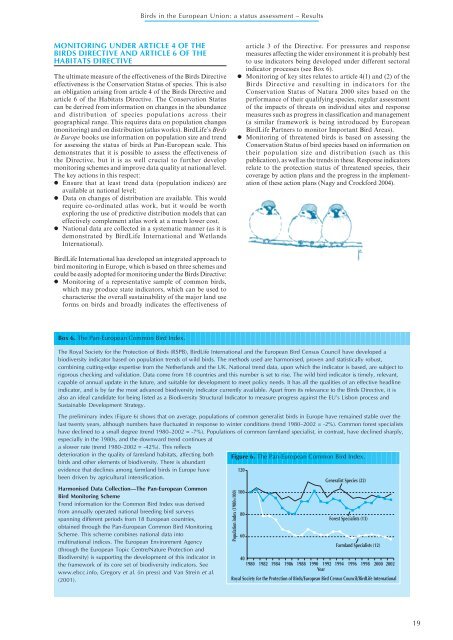Birds in the European Union - BirdLife International
Birds in the European Union - BirdLife International
Birds in the European Union - BirdLife International
Create successful ePaper yourself
Turn your PDF publications into a flip-book with our unique Google optimized e-Paper software.
MONITORING UNDER ARTICLE 4 OF THE<br />
BIRDS DIRECTIVE AND ARTICLE 6 OF THE<br />
HABITATS DIRECTIVE<br />
The ultimate measure of <strong>the</strong> effectiveness of <strong>the</strong> <strong>Birds</strong> Directive<br />
effectiveness is <strong>the</strong> Conservation Status of species. This is also<br />
an obligation aris<strong>in</strong>g from article 4 of <strong>the</strong> <strong>Birds</strong> Directive and<br />
article 6 of <strong>the</strong> Habitats Directive. The Conservation Status<br />
can be derived from <strong>in</strong>formation on changes <strong>in</strong> <strong>the</strong> abundance<br />
and distribution of species populations across <strong>the</strong>ir<br />
geographical range. This requires data on population changes<br />
(monitor<strong>in</strong>g) and on distribution (atlas works). <strong>BirdLife</strong>’s <strong>Birds</strong><br />
<strong>in</strong> Europe books use <strong>in</strong>formation on population size and trend<br />
for assess<strong>in</strong>g <strong>the</strong> status of birds at Pan-<strong>European</strong> scale. This<br />
demonstrates that it is possible to assess <strong>the</strong> effectiveness of<br />
<strong>the</strong> Directive, but it is as well crucial to fur<strong>the</strong>r develop<br />
monitor<strong>in</strong>g schemes and improve data quality at national level.<br />
The key actions <strong>in</strong> this respect:<br />
Ensure that at least trend data (population <strong>in</strong>dices) are<br />
available at national level;<br />
Data on changes of distribution are available. This would<br />
require co-ord<strong>in</strong>ated atlas work, but it would be worth<br />
explor<strong>in</strong>g <strong>the</strong> use of predictive distribution models that can<br />
effectively complement atlas work at a much lower cost.<br />
National data are collected <strong>in</strong> a systematic manner (as it is<br />
demonstrated by <strong>BirdLife</strong> <strong>International</strong> and Wetlands<br />
<strong>International</strong>).<br />
<strong>BirdLife</strong> <strong>International</strong> has developed an <strong>in</strong>tegrated approach to<br />
bird monitor<strong>in</strong>g <strong>in</strong> Europe, which is based on three schemes and<br />
could be easily adopted for monitor<strong>in</strong>g under <strong>the</strong> <strong>Birds</strong> Directive:<br />
Monitor<strong>in</strong>g of a representative sample of common birds,<br />
which may produce state <strong>in</strong>dicators, which can be used to<br />
characterise <strong>the</strong> overall susta<strong>in</strong>ability of <strong>the</strong> major land use<br />
forms on birds and broadly <strong>in</strong>dicates <strong>the</strong> effectiveness of<br />
Box 6. The Pan-<strong>European</strong> Common Bird Index.<br />
article 3 of <strong>the</strong> Directive. For pressures and response<br />
measures affect<strong>in</strong>g <strong>the</strong> wider environment it is probably best<br />
to use <strong>in</strong>dicators be<strong>in</strong>g developed under different sectoral<br />
<strong>in</strong>dicator processes (see Box 6).<br />
Monitor<strong>in</strong>g of key sites relates to article 4(1) and (2) of <strong>the</strong><br />
<strong>Birds</strong> Directive and result<strong>in</strong>g <strong>in</strong> <strong>in</strong>dicators for <strong>the</strong><br />
Conservation Status of Natura 2000 sites based on <strong>the</strong><br />
performance of <strong>the</strong>ir qualify<strong>in</strong>g species, regular assessment<br />
of <strong>the</strong> impacts of threats on <strong>in</strong>dividual sites and response<br />
measures such as progress <strong>in</strong> classification and management<br />
(a similar framework is be<strong>in</strong>g <strong>in</strong>troduced by <strong>European</strong><br />
<strong>BirdLife</strong> Partners to monitor Important Bird Areas).<br />
Monitor<strong>in</strong>g of threatened birds is based on assess<strong>in</strong>g <strong>the</strong><br />
Conservation Status of bird species based on <strong>in</strong>formation on<br />
<strong>the</strong>ir population size and distribution (such as this<br />
publication), as well as <strong>the</strong> trends <strong>in</strong> <strong>the</strong>se. Response <strong>in</strong>dicators<br />
relate to <strong>the</strong> protection status of threatened species, <strong>the</strong>ir<br />
coverage by action plans and <strong>the</strong> progress <strong>in</strong> <strong>the</strong> implementation<br />
of <strong>the</strong>se action plans (Nagy and Crockford 2004).<br />
The Royal Society for <strong>the</strong> Protection of <strong>Birds</strong> (RSPB), <strong>BirdLife</strong> <strong>International</strong> and <strong>the</strong> <strong>European</strong> Bird Census Council have developed a<br />
biodiversity <strong>in</strong>dicator based on population trends of wild birds. The methods used are harmonised, proven and statistically robust,<br />
comb<strong>in</strong><strong>in</strong>g cutt<strong>in</strong>g-edge expertise from <strong>the</strong> Ne<strong>the</strong>rlands and <strong>the</strong> UK. National trend data, upon which <strong>the</strong> <strong>in</strong>dicator is based, are subject to<br />
rigorous check<strong>in</strong>g and validation. Data come from 18 countries and this number is set to rise. The wild bird <strong>in</strong>dicator is timely, relevant,<br />
capable of annual update <strong>in</strong> <strong>the</strong> future, and suitable for development to meet policy needs. It has all <strong>the</strong> qualities of an effective headl<strong>in</strong>e<br />
<strong>in</strong>dicator, and is by far <strong>the</strong> most advanced biodiversity <strong>in</strong>dicator currently available. Apart from its relevance to <strong>the</strong> <strong>Birds</strong> Directive, it is<br />
also an ideal candidate for be<strong>in</strong>g listed as a Biodiversity Structural Indicator to measure progress aga<strong>in</strong>st <strong>the</strong> EU’s Lisbon process and<br />
Susta<strong>in</strong>able Development Strategy.<br />
The prelim<strong>in</strong>ary <strong>in</strong>dex (Figure 6) shows that on average, populations of common generalist birds <strong>in</strong> Europe have rema<strong>in</strong>ed stable over <strong>the</strong><br />
last twenty years, although numbers have fluctuated <strong>in</strong> response to w<strong>in</strong>ter conditions (trend 1980–2002 = -2%). Common forest specialists<br />
have decl<strong>in</strong>ed to a small degree (trend 1980–2002 = -7%). Populations of common farmland specialist, <strong>in</strong> contrast, have decl<strong>in</strong>ed sharply,<br />
especially <strong>in</strong> <strong>the</strong> 1980s, and <strong>the</strong> downward trend cont<strong>in</strong>ues at<br />
a slower rate (trend 1980–2002 = -42%). This reflects<br />
deterioration <strong>in</strong> <strong>the</strong> quality of farmland habitats, affect<strong>in</strong>g both Figure 6. The Pan-<strong>European</strong> Common Bird Index.<br />
birds and o<strong>the</strong>r elements of biodiversity. There is abundant<br />
evidence that decl<strong>in</strong>es among farmland birds <strong>in</strong> Europe have<br />
120<br />
been driven by agricultural <strong>in</strong>tensification.<br />
Generalist Species (22)<br />
Harmonised Data Collection—The Pan-<strong>European</strong> Common<br />
Bird Monitor<strong>in</strong>g Scheme<br />
Trend <strong>in</strong>formation for <strong>the</strong> Common Bird Index was derived<br />
from annually operated national breed<strong>in</strong>g bird surveys<br />
spann<strong>in</strong>g different periods from 18 <strong>European</strong> countries,<br />
obta<strong>in</strong>ed through <strong>the</strong> Pan-<strong>European</strong> Common Bird Monitor<strong>in</strong>g<br />
Scheme. This scheme comb<strong>in</strong>es national data <strong>in</strong>to<br />
mult<strong>in</strong>ational <strong>in</strong>dices. The <strong>European</strong> Environment Agency<br />
(through <strong>the</strong> <strong>European</strong> Topic Centre/Nature Protection and<br />
Biodiversity) is support<strong>in</strong>g <strong>the</strong> development of this <strong>in</strong>dicator <strong>in</strong><br />
<strong>the</strong> framework of its core set of biodiversity <strong>in</strong>dicators. See<br />
www.ebcc.<strong>in</strong>fo, Gregory et al. (<strong>in</strong> press) and Van Stre<strong>in</strong> et al.<br />
(2001).<br />
<strong>Birds</strong> <strong>in</strong> <strong>the</strong> <strong>European</strong> <strong>Union</strong>: a status assessment – Results<br />
Population <strong>in</strong>dex (1980=100)<br />
100<br />
80<br />
60<br />
Forest Specialists (13)<br />
Farmland Specialists (12)<br />
40<br />
1980 1982 1984 1986 1988 1990 1992 1994 1996 1998 2000 2002<br />
Year<br />
Royal Society for <strong>the</strong> Protection of <strong>Birds</strong>/<strong>European</strong> Bird Census Council/<strong>BirdLife</strong> <strong>International</strong><br />
19

















